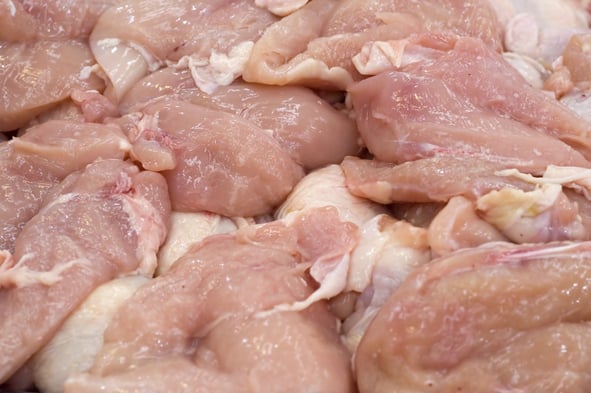The essential info as of 9:00AM Wednesday, October 9th:
Salmonella Heidelberg has been found in Foster Farms Raw Chicken.
Salmonella Heidelberg is a strain of the bacterium Salmonella, a common cause of food-born illness.
Per the CDC’s website:
“As of October 7, 2013 a total of 278 persons infected with seven strains of Salmonella Heidelberg have been reported from 17 states."
42% of the 278 persons infected have been hospitalized.
Because of government shutdown, certain CDC workers were furloughed. The outbreak however, has led to the CDC calling many of it’s food monitoring staff back to work, in order to investigate the outbreak.
States with reported cases:
- Arizona
- Arkansas
- Alaska
- California (77% of cases)
- Colorado
- Connecticut
- Florida
- Hawaii
- Idaho
- Illinois
- Michigan
- Nevada
- North Carolina
- Oregon
- Texas
- Utah
- Washington
- Wisconsin
Where further information can be found:
CDC returns to work (via CBS news)
What Dickson can contribute:
The above information was simplified because it can be found at multiple news outlets. We’ve honed in on a few specific aspects of the story below, specifically the traditional, non-government shutdown roles of the FDA, CDC, and USDA in food quality monitoring, and the bacteria’s ideal temperature for growth.
Salmonella is a bacterium which lives in the gastrointestinal tracts of animals and humans. It is transferred from animal to animal and animal to human through direct contact and animal feces. Contamination usually happens on butchering of raw meat, or when an infected chicken produces eggs.
Regulatory Agencies:
The three government agencies involved in the latest outbreak are the FDA, USDA, and CDC. We have outlined each agencies role in preventing salmonella, and dealing with a salmonella outbreak below.
FDA:
The FDA provides guidance documents, audits, and testing for foods and drugs in the United States. While the USDA works with eggs, meat, and poultry, the FDA issues guidelines for industries, and works with the USDA and CDC in implementing procedures to reduce the risk of cross contamination at food production facilities. You can find their Guidance for Testing Salmonella species in Human Foods by clicking here.
Also, the FDA has an Inspections Operations Manual. In the future, we will summarize this information for you.
CDC:
The CDC tracks outbreaks. With the government shutdown they got a two-day late head start on connecting the dots between potential infections of salmonella. As they have been recalled (bad pun) to work, they will again be the lead coordinator between local, state, and federal agencies in investigating this outbreak. While the FDA and USDA/FSIS attempt to control the outbreak, the CDC monitors whether the outbreak is over. Pulsenet has and will be a key factor of investigation and control of this salmonella outbreak.
USDA/FSIS:
FSIS stands for Food Safety and Inspection Services, and is a subsidiary of the USDA. They show up at egg, meat, and poultry producer's doors and audit those producers on predetermined points. Specifically, they look to test random machines for cleanliness and bacterial count. The FSIS does some tests at the facility. At a facility with 70 production machines, they may test 5. On the temperature side of the audit, the USDA/FSIS looks for an accurate and complete 3-year audit trail. They will randomly pick date and times (usually in 1-2 hour increments) and essentially look to see that temperature was recorded, and what the temperature value was of a given environment. USDA investigators began investigating 4 Foster Farms plants after the CDC alerted them to connected cases of salmonella poisoning on the West Coast in July of this year.
Communication between these agencies is critical. As the CDC monitors, the FDA and USDA investigate. As the USDA investigates, the CDC monitors.
Ideal temperatures for growth:
Temperatures between 7-48C (44.6-118.4F) are ideal for Salmonella growth. Growth is limited when facilities properly refrigerate or freeze of foods. Refrigerator and freezer monitoring, specifically with alarm settings for when temperatures exceed predetermined amounts, is essential to limiting the growth of salmonella in already contaminated foods, as foods that reach ideal temperature growth conditions can be evaluated for possible discard.
Ideal temperatures for infection:
Don't eating contaminated food that has not been cooked to 165F. Food contaminated with Salmonella can be eaten if the food (for example Foster Farms Chicken) reaches an internal temperature of 165F. Use of a meat thermometer while cooking raw meat will greatly reduce your risk of infection. Also, containing the bacteria with clean surfaces and diligent washing of hands is critical.

